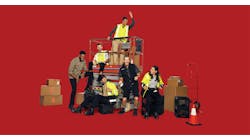Across the country, many businesses and industries have dress codes – from corporate offices, to manufacturing plants, to truck repair facilities, to fast food restaurants, etc. There are dress codes for those involved in sports, scouting and member organizations.
Any employee whose employer has a dress, hair or uniform code knows that if they show up out of code, they will be sent home, face other disciplinary action and/or termination.
In recent months, there have been many stories about dress code infractions, including the men’s pair at Wimbledon who had to change their black underwear to white – in accordance with the rules – and the increase in dress code for the Ladies Professional Golf Association (LPGA).
We have rules in all aspects of our lives. We may not like or agree with many of these rules, but the majority of us choose to adhere to them and go about our lives.
For some reason, though, it seems that dress codes, especially those created by schools, aren’t part of the rules. That is not a good thing.
Many years ago, my high school Spanish teacher taught me that if there are no consequences, there are no rules. In this class, like many others, the rules were the rules. If you crossed the line, there were appropriate repercussions, and we were all better off for it.
Not that Important
When speaking to educators and administrators about school rules, especially tardiness and dress code, they seem to believe that these rules are about distractions and are not that important in the big picture of education. To those I ask: Isn’t it important that students know these rules are important in the workforce and truly are part of preparing them for the world after education?
Sometimes, educators don’t understand or believe that part of educating is to teach or enforce rules that don’t pertain to the subject they teach in their classrooms.
The conversations around the shortage of skilled workers, and more importantly, qualified workers, continue to grow. Ask an employer if they have a shortage of applicants or a shortage of qualified applicants and more than 80 percent will say qualified applicants. Many either can’t pass the drug test or their dress and appearance, when coming for an interview, doesn’t instill confidence in the potential employer.
My good friend, Steve Johnson of NHRA Racer, holds presentations for students and schools across the country on Branding Yourself after the Diploma. He teaches students that they are a brand, just like a product they buy at Wal-Mart, and they need to present themselves in the best possible light.
I explain to those coming into our industry that when others see you for the first time, or in different environments, they form first impressions. But it’s not until they actually meet you and you open your mouth that you cement or change those impressions.
Johnson shows students how to separate themselves from the others applying for the same job. The information he works to impart to students enables them to stand out from the crowd and learn ways to make themselves noticed in a positive way to perspective employers.
The Same Purpose
School dress codes can serve the same purpose. When we, as a business and industry, are involved with schools and advisory committees, we need to let educators know how important the enforcement of simple rules, like dress codes and tardiness, are to us and the overall success of their students.
If schools would enforce the rules equally among all students, every day, many of the concerns we face in the workforce would potentially go away. Education’s lack of enforcement allows students to believe these rules are not that important. Unfortunately, in this business and industry, these rules are important and non-negotiable. What’s more, many are safety related.
Tardiness, which is an even larger industry concern, is sometimes overlooked. In most jobs, three “tardies” will get you fired.
Ask any employer what is the number one reason for termination. The majority of the time, they will say it is being late to work. You can’t run a workforce, make products, service customers or maintain the infrastructure of our country when employees don’t show up to work.
Role Models
When working with schools or at conferences with educators and administrators, I notice that the dress and appearance of some teachers and administrators make it easy to understand why students dress the way they do. As educators, professors and administrators at all levels, your appearance – your brand – is what others see.
What brand are you conveying? Is it the brand you want the industry and parents to see? Remember, water seeks its own level.
Our workforce greatly needs workers. Let’s give students at every level all of the tools they need to enter and be successful in the workforce.
George Arrants is the training consultant for K&D Technical Innovations (www.kdtechnicalinnovations.com), the company that developed and provided oscilloscope and communication errors training for WheelTime truck and coach repair members and others. As an automotive education consultant specializing in National Automotive Technicians Education Foundation (NATEF)/ASE Accreditation, Arrants works with instructors and administrators to develop partnerships with local business and industry through program advisory committees. These committees help schools establish, develop and maintain programs that are relevant to the needs of automotive, medium and heavy duty and collision industries and the community. He chairs the Technology and Maintenance Council’s TMCSuperTech – the National Technician Skills Competition – and the TMCFutureTech – the National Student Technician Competition. His entire career has been in the automotive service and education industries.




